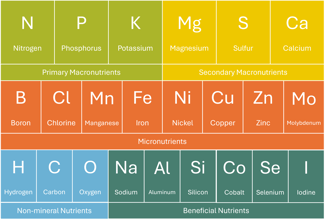Plant Nutrients: A New Definition to Advance Agricultural Production


What is a plant nutrient?
Plant scientists as well as regulatory bodies largely follow a strict definition of essential nutrients for plants that was originally proposed in 1939. This very restrict definition of essentiality considers an element as a plant nutrient only in the context of the completion of the lifecycle of the plant.
Current definitions of essential or beneficial elements for plant growth rely on narrowly defined criteria that do not fully represent a new vision for plant nutrition and compromise fertilizer regulation and practice. A new definition of what is a plant nutrient that is founded in science and relevant in practice has therefore the potential to revitalize innovation and discovery.
It excludes from consideration other beneficial plant nutrients that will ‘only’ enhance plant growth, improve the efficiency of utilization of nutrients, water, and other resources, enhance abiotic or biotic stress tolerance, or improve the quality or nutritional value of the harvested crop. More recently, early 1980s, the term beneficial elements became popular to include elements that stimulate plant growth or health but have not been shown so far to meet the strict essentiality criteria. To be considered an essential nutrient, three criteria must be met:
1. A given plant must be unable to complete its lifecycle in the absence of the element.
2. The function of the element must not be replaceable by another element.
3. The element must be directly involved in plant metabolism, or it must be required for a distinct metabolic step such as an enzyme reaction.
Beneficial elements are defined as elements that stimulate growth, but are not essential according to these three criteria, or are essential only for certain plant species, or under specific conditions. In summary, beneficial elements might improve agricultural production but not prove essentiality.
A new definition of plant nutrient
Global climatic changes are likely to result in more stressful conditions for crop production, and there are significant needs and opportunities to produce more nutritious food. Therefore, a modern definition of what is a ‘plant nutrient’ - grounded in science and relevant in practice - is the foundation for a holistic crop nutrition contribution to food system transformation and sustainable development. This could include a consideration of the role that nutrients in the environment can play in enhancing plant productivity even when that element is not essential and has no specific role in a plant metabolic process. For example, we now know that plant-associated microbiomes confer fitness advantages to the plant host, including growth promotion, nutrient uptake, stress tolerance and resistance to pathogens. Given the critical role the plant microbiome plays in all that, one might hypothesize that a nutrient ‘essential for the microbiome’ would in turn also be critical for optimal plant productivity, particularly under stress. Nutrient elements that are essential for microbiome function may in turn influence plant microbiome activity and consequently crop productivity. Elements such as sodium (Na), silicon (Si), selenium (Se), aluminum (Al), cobalt (Co) or iodine (I) are known to also beneficially impact plant growth, but they are relegated to a legal and practical ‘no man’s land’.
Many in the global scientific community, as well as agricultural producers, policy makers and industry who are engaged in agriculture, nutrition, and environment, have embraced this new vision but may find the science of plant nutrition and its practical implementation constrained by a too tight definition of a ‘plant nutrient’. The goal of the proposed new definition is not to redefine the term ‘essential plant nutrient’. However, to properly define the term ‘plant nutrient’, through a single definition that encapsulates both elements that are essential and beneficial for plants, as well as those that are important for other uses, such as animal and human nutrition, should be discussed. A new definition would read:
“A mineral plant nutrient is an element which is essential or beneficial for plant growth and development or for the quality attributes of the harvested product of a given plant species grown in its natural or cultivated environment. A plant nutrient may be considered essential if the life cycle of a diversity of plant species cannot be completed in the absence of the element. A plant nutrient may be considered beneficial if it does not meet the criteria of essentiality, but can be shown to benefit plant growth and development or the quality attributes of a plant or its harvested product.”
The establishment of the current essential plant nutrients has largely been achieved by growing plants in highly refined culture media under controlled experimental conditions. This approach is fundamentally disconnected from the reality of agricultural production or natural environments in which environmental stress, nutrient interactions and the microbiome all affect plant performance. Besides emphasis on plant biomass (yield), this new definition also covers benefits in terms of plant health (e.g. tolerance to abiotic stresses or resistance to pests and diseases) and the quality of the harvested commercial products for their different end uses. This also provides a much-needed opportunity to link plant nutrition more directly to animal and human nutrition, a requirement that was stated a long time ago.
The new definition of plant nutrients would lead to several positive outcomes. For example, farmers will be freed to fully explore the holistic vision of ‘plant nutrition’ that includes integrated roles of plant nutrients on stress tolerance, efficiency of resource use, crop quality and whole system sustainability. Regulators and government agencies will achieve a more nuanced, integrative, adaptable, and modern interpretation of what is a plant nutrient, and consumers will also benefit from enhanced productivity and food that could be a lot more nutritious.
*The above information was summarized/adapted from the article “What is a plant nutrient? Changing definitions to advance science and innovation in plant nutrition” by Patrick H. Brown, Fang-Jie Zhao & Achim Dobermann, originally published in Plant and Soil Science, Volume 476, pages 11–23, 2022.
Plants need 17 essential elements to complete their lifecycle but beneficial elements have also demonstrated clear benefits to plant productivity, crop quality, resource use efficiency, stress tolerance and/or pest and disease resistance.
